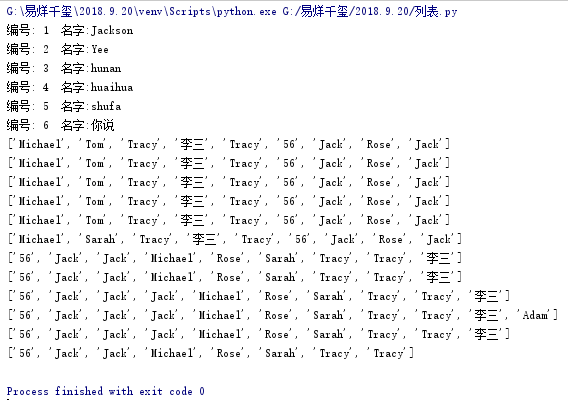作业3
2018-09-21 13:57 cqchenqin 阅读(302) 评论(0) 编辑 收藏 举报# 1.列表的遍历 list = ['Jackson','Yee','hunan','huaihua','shufa','你说'] for i in range(len(list)): print("编号: %s 名字:%s"% (i+1,list[i])) # 定义 # classmates = ['Michael', 'Bob', 'Tracy','李三' ,'Tracy','56'] new = ['Rose','Jack'] classmates.insert(2,'Tom') classmates.append('Jack') classmates.extend(new) classmates.pop(1) print(classmates) print(classmates) # 取元素或片段 # classmates[1],classmates[-1], classmates[1:3] print(classmates) # 取属性len # len(classmates),max(classmates), min(classmates) print(classmates) # 取元素的索引 # classmates.index('Tracy') print(classmates) # 修改 # classmates[1] = 'Sarah' print(classmates) # 排序 # classmates.sort() print(classmates) #没有返回值,改变列表本身 # 计数 # classmates.count('Tracy') print(classmates) # 插入 classmates.insert(1, 'Jack') print(classmates) # 追加 classmates.append('Adam') print(classmates) # 扩展 list.extend(ls) # 弹出 classmates.pop() print(classmates) # 删除 classmates.pop(1) del classmates[-1] print(classmates)

# 元组的遍历 t = ('a','b',['A','B']) t [2][0] = 'X' t [2][1] = 'Y' for i in range(len(t)): print(t[i])

# 集合的遍历 s = {1,2,3} print(s) # 增加 s.add(4) print(s) # 删除 s.remove(4) print(s) # 生成 s = set({1,1,2,2,3,3}) print(s) # 集合运算 s1 = set([1,2,3]) print(s1) s2 = set([2,3,4]) print(s2) s1 & s2 print(s1 & s2) s1 | s2 print(s1 | s2) s2 - s1 print(s2 - s1) for i1 in s1: print(s1) for i2 in s2: print(s2)

# 字典的遍历 dict1= {'Bob': 75, 'Michael': 95, 'Tracy': 85} for key in dict1: print(dict1[key]) classmates= ['Michael', 'Bob', 'Tracy'] score = [95, 75, 85] cs = dict(zip(classmates,score)) print(cs) print(list('ababcd'),tuple('ababcd')) d = {'Bob': 75, 'Michael': 95, 'Tracy': 85} # 取值 d['Michael'] len(d) # 判断key有否 'Thomas' in d # 添加与修改 d['Rose'] = 88 # 删除 d.pop('Bob') d.keys() d.values() d.items() d={}

# 1.下载已收英文歌词或文章str strYee = '''I know exactly what to do You make these dreams come true And you've been there through and through So that's why I sing to you like (Ah ah) I won't I won't I won't stop now (Ah ah) I know I know I want that crown I'm steady making these moves I'm steady making these moves I got nothing nothing nothing to lose I'm steady making these moves I'm steady making these moves I got nothing nothing nothing to lose My heart only beats for you I got a lot of things to prove I would travel to the moon If you be there with me too like (Ah ah) I won't I won't I won't stop now (Ah ah) I know I know I want that crown I'm steady making these moves I'm steady making these moves I got nothing nothing nothing to lose I'm steady making these moves I'm steady making these moves I got nothing nothing nothing to lose Oooooo Shooting for the stars shooting for the stars Oooooo We made it this far we made it this far (Ah ah) I won't I won't I won't stop now (Ah ah) I know I know I want that crown I'm steady making these moves I'm steady making these moves I got nothing nothing nothing to lose I'm steady making these moves I'm steady making these moves I got nothing nothing nothing to lose I'm steady making these moves I'm steady making these moves I got nothing nothing nothing to lose I'm steady making these moves I'm steady making these moves I got nothing nothing nothing to lose''' str.lower(strYee) strList = strYee.split()aaa print(strList) # 排序 strList.sort() print(strList) # 2.分隔出一个一个的单词list strList = strYee.split() print(strList) print(len(strList),strList) # 3.统计每个单词出现的次数dict strSet=set(strList) print(len(strSet),strSet) strDic={ } for word in strSet: strDic[word]=strList.count(word) print(len(strDic),strDic)

列表,元组,字典,集合的联系与区别
一、列表
1.任意对象的有序集合:列表是一组任意类型的值,按照一定顺序组合而成的
2.通过偏移读取 :组成列表的值叫做元素(Elements)。每一个元素被标识一个索引,第一个索引是0,序列的功能都能实现
3.可变长度,异构以及任意嵌套 :列表中的元素可以是任意类型,甚至是列表类型,也就是说列表可以嵌套
4.可变的序列 :支持索引、切片、合并、删除等等操作,它们都是在原处进行修改列表
5.对象引用数组 :列表可以当成普通的数组,每当用到引用时,Python总是会将这个引用指向一个对象,所以程序只需处理对象的操作。当把一个对象赋给一个数据结构元素或变量名时,Pythoy总是会存储对象的引用,而不是对象的一个拷贝
二、元组
1.任意对象的有序集合:与列表相同
2.通过偏移存取 :与列表相同
3.属于不可变序列类型 :类似于字符串,但元组是不可变的,不支持在列表中任何原处修改操作,不支持任何方法调用
4.固定长度、异构、任意嵌套 :固定长度即元组不可变,在不被拷贝的情况下长度固定,其他同列表
5.对象引用的数组 :与列表相似,元祖是对象引用的数组,和list相比 ①比列表操作速度快 ,②对数据“写保护“ ,③可用于字符串格式化中 ,④可作为字典的key。
三、字典
1.通过键而不是偏移量来读取 :字典就是一个关联数组,是一个通过关键字索引的对象的集合,使用键-值(key-value)进行存储,查找速度快
2.任意对象的无序集合 :字典中的项没有特定顺序,以“键”为象征
3.可变长、异构、任意嵌套 :同列表,嵌套可以包含列表和其他的字典等
4.属于可变映射类型 :因为是无序,故不能进行序列操作,但可以在远处修改,通过键映射到值。字典是唯一内置的映射类型(键映射到值的对象)
5.对象引用表 :字典存储的是对象引用,不是拷贝,和列表一样。字典的key是不能变的,list不能作为key,字符串、元祖、整数等都可以和list比较,dict有以下几个特点: ①查找和插入的速度极快,不会随着key的增加而增加 ;②需要占用大量的内存,内存浪费多;而list相反: ①查找和插入的时间随着元素的增加而增加 ;②占用空间小,浪费内存很少 ,所以,dict是用空间来换取时间的一种方法
四、集合
1.是一组key的集合,但不存储value,并且key不能重复 ,创建一个set,需要提供一个list作为输入集合,s = set([1,2,3]),注意,传入的参数 [1, 2, 3] 是一个list,而显示的 set([1, 2, 3]) 只是告诉你这个set内部有1,2,3这3个元素,显示的[ ]不表示这是一个list
2.重复元素在set中自动被过滤 :set可以看成数学意义上的无序和无重复元素的集合,因此,两个set可以做数学意义上的交集、并集等操作,还有一种集合是forzenset( ),是冻结的集合,它是不可变的,存在哈希值,好处是它可以作为字典的key,也可以作为其它集合的元素。缺点是一旦创建便不能更改,没有add,remove方法和dict对比 ①set和dict的唯一区别仅在于没有存储对应的value ;②set的原理和dict一样,同样不可以放入可变对象,因为无法判断两个可变对象是否相等,也就无法保证set内部“不会有重复元素”。

